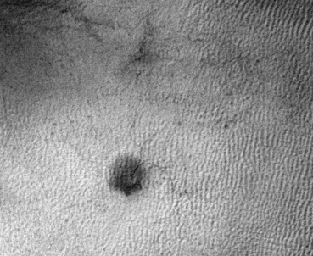
|
‘Baby Spider’: Growth of a Martian Trough Network
- Click the image above for a larger view
 Movie Download Options
Movie Download Options- Full-Res JPEG (369 x 302) (24.8 kB)
- Full-Res TIFF (369 x 302) (111.8 kB)
Caption:
This sequence of three images shows the growth of a branching network of troughs carved by thawing carbon dioxide over the span of three Martian years. This process is believed to also form larger radially patterned channel features known as Martian " spiders ."
The images were taken by the High Resolution Imaging Science Experiment (HiRISE) camera on NASA's Mars Reconnaissance Orbiter and included in a report on the first detection of such troughs persisting and growing, from one Mars year to the next.
The ground area included in this animated GIF sequence spans about 640 feet (195 meters) across, at 70 degrees south latitude, 178 degrees east longitude. The three images are excerpts from HiRISE observations ESP_014185_1095 , taken Aug. 5, 2009; ESP_023600_1095 , taken Aug. 9, 2011; and ESP_041402_1095 , taken May 25, 2015. The sequence repeats multiple times.
Background Info:
HiRISE is one of six instruments on the Mars Reconnaissance Orbiter, which began examining Mars in 2006. The University of Arizona, Tucson, operates HiRISE, which was built by Ball Aerospace & Technologies Corp., Boulder, Colorado. NASA's Jet Propulsion Laboratory, a division of Caltech in Pasadena, California, manages the Mars Reconnaissance Orbiter Project for NASA's Science Mission Directorate, Washington. Lockheed Martin Space Systems, Denver, built the orbiter and collaborates with JPL to operate it.
Cataloging Keywords:
| Name | Value | Additional Values |
|---|---|---|
| Target | Mars | |
| System | ||
| Target Type | Planet | |
| Mission | Mars Reconnaissance Orbiter (MRO) | |
| Instrument Host | Mars Reconnaissance Orbiter | |
| Host Type | Orbiter | |
| Instrument | High Resolution Imaging Science Experiment (HiRISE) | |
| Detector | ||
| Extra Keywords | Grayscale, Movie | |
| Acquisition Date | ||
| Release Date | 2016-12-20 | |
| Date in Caption | 2009-08-05 | 2011-08-09, 2015-05-25 |
| Image Credit | NASA/JPL-Caltech/Univ. of Arizona | |
| Source | photojournal.jpl.nasa.gov/catalog/PIA21257 | |
| Identifier | PIA21257 | |
